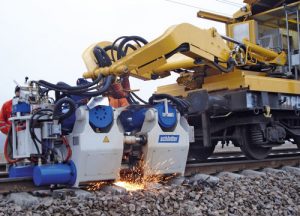What Is Flash Butt Welding?
Flash butt welding is a special type of resistance welding that surprisingly doesn’t use any filler materials at all. The energy is transferred by the heat created by the parts being welded themselves. The connecting parts are gently held together while the flashing voltage is applied, and are gently pushed together. The process can technically be performed by hand, but most professionals prefer to perform flash butt welding through welding machines.
Today, flash butt welding has become widely used because it allows for combining a variety of section sizes and complex shapes together.
What Is the Difference Between Butt Welding and Flash Butt Welding?
Flash butt welding equipment and traditional butt welding equipment look very similar at first glance, and even have some things in common. For example, the heat sources for both approaches is the resistance to the electric current generated by the opposing surfaces. However, both have some key differences users should noite before investing in either.
Traditional Butt Welding
The biggest difference is that traditional butt welding processes bring the pieces to be welded together under high pressure, followed by the contact area being heated enough to bind them together. It’s a single-stage process that uses current and pressure to get the job done, and the weld is smooth and symmetrical without any noticeable jagged edges.
Flash Butt Welding
 In flash butt welding, the energy required for connecting the parts comes from resistive heat generated by the parts themselves. After they have been separated, a current is applied to the pieces, which makes the metal melt due to resistance and an arc between the two pieces. After the parts to be connected are sufficiently molten, they are forced together under high pressure, making them join.
In flash butt welding, the energy required for connecting the parts comes from resistive heat generated by the parts themselves. After they have been separated, a current is applied to the pieces, which makes the metal melt due to resistance and an arc between the two pieces. After the parts to be connected are sufficiently molten, they are forced together under high pressure, making them join.
This simple process means there’s no need for the usual filler materials, and the flashing also gradually adds warmth at the piece ends, resulting in the removal of oxides and a number of other impurities.
What Are the Advantages of Flash Butt Welding?
Here’s a breakdown of the major advantages you get from using flash butt welding:
- This welding process requires much less power than other types of welding.
- The surfaces to be welded don’t require any previous preparation before the welding is done.
- It’s very, very cheap, and saves you a lot of money in the long run.
- Flash butt welding can be used to weld metals with different melting temperatures.
What Are the Applications of Flash Butt Welding?
The most common use for flash butt welding is railroad manufacturing, where its capability to provide highly-precise welds with low cost allows the manufacturing of large lengths of railroad continue to operate at ease. This welding method also doesn’t need any filler materials, which makes the process easier and the investment required even lower.
Flash butt welding is also used for other applications like the manufacturing of wire-mesh, fences, etc.
Flash Butt Welding Solutions by Maco Corp: The Takeaway
With that said, though, you’ll have to look close if you want to find the most reliable flash butt welding services.
That’s where Maco Corporation comes in. As one of the most well known construction equipment companies in India, Maco Corporation provides the best flash butt welding equipment at competitive rates. It doesn’t end there either: you’re also entitled to machine servicing, provided by the best Maco Corp. technicians. As a Maco Corp. customer, you’re guaranteed to get the best services at affordable rates.
